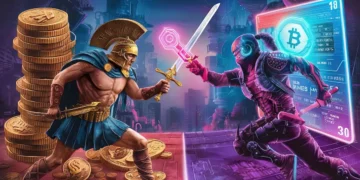The rapid pace of development is clearly reflected in the digital world, especially with the rise of revolutionary Web3 technology. Simply hearing the term is often associated with a hacker’s mysterious excitement behind a crypto wallet, but it doesn’t capture its full meaning. What’s less obvious is how Web3 is quietly making its way into the everyday apps we use, from gaming and social media to finance. This shift is changing the way we fundamentally interact with technology. Learn how Web3 could signal the end of traditional mobile apps and why it matters to users like you.
What Is Web3, and Why Mobile Apps?
Web3 is the next step for the internet, using decentralized tech like blockchain, smart contracts, and token systems. Unlike Web2, which depends on central servers and big companies, Web3 focuses on users owning their data, being open, and trusting the system without middlemen. Since most people use mobile apps to get online, these apps are a great way to bring Web3 ideas to everyone. With over 6.6 billion people using smartphones, apps can easily introduce decentralized tech, often without users even noticing.
For instance, some mobile betting apps are harnessing blockchain technology to deliver secure, transparent transactions that are recorded on a public ledger, ensuring fairness and building trust among players. Curious about how these apps are revolutionizing online gambling with Web3 innovations? Find more information here.
Developers are adding Web3 features to apps to make them more secure, give users better control over their data, and create new ways to earn money. Whether it’s a game that rewards players with digital items or a social app that lets people trade directly, Web3 is becoming a natural part of the mobile experience.
The Subtle Integration of Web3 in Mobile Apps
The beauty of Web3’s adoption in mobile apps lies in its subtlety. Developers are prioritizing user experience, ensuring that blockchain-based features feel intuitive rather than disruptive. Here’s how this integration is happening across various app categories:
Gaming Apps: Play-to-Earn and Digital Ownership
Mobile gaming is a big reason why more people are using Web3. Play-to-earn (P2E) games let players earn digital items like NFTs or cryptocurrencies, which they can trade or sell. Games like Axie Infinity and The Sandbox made this popular, and now smaller apps are doing the same. Even casual mobile games are starting to give players tokenized rewards, such as unique skins or in-game money, that have real value.
What’s exciting is the move to real digital ownership. Unlike regular games where your purchases stay on one platform, Web3 apps let players truly own their items on the blockchain. So, you could sell your rare in-game sword to someone else or move it to another game, all without needing a middleman.
Social Media: Decentralized Communities
Social media apps are starting to explore Web3 technology. Platforms like Lens Protocol and Steemit use blockchain to build decentralized social networks where users own their data and content. Instead of companies making money from your posts, Web3 social apps reward creators with tokens for engagement or let users tip each other directly. These apps are still small but growing, with mobile designs that feel similar to Instagram or TikTok.
This change gives users more control, moving away from centralized platforms where algorithms decide what you see. Decentralized social apps focus on being open and putting users in charge of content, making them a good option for people who care about privacy.
Finance and Payments: Wallets in Your Pocket
Mobile finance apps are embracing Web3 through decentralized finance (DeFi) and crypto wallets. Some apps let users manage cryptocurrencies, interact with DeFi protocols, and even purchase NFTs—all from their phones. Traditional fintech apps are also integrating Web3 features. For instance, some mobile banking apps now allow users to buy and hold Bitcoin or Ethereum alongside their regular savings.
This convergence of Web3 and mobile finance is democratizing access to decentralized economies. Users can lend, borrow, or stake assets directly from their phones, bypassing traditional financial institutions. It’s a quiet revolution that’s making finance more inclusive.
Other Industries: From Betting to Health
Web3 goes beyond just gaming and finance. Even health apps are getting involved, using blockchain to safely store medical records or giving users tokens as rewards for hitting fitness goals. These examples show how flexible Web3 can be when combined with mobile technology.
Benefits of Web3 in Mobile Apps
The integration of Web3 into mobile apps brings tangible benefits for users and developers alike. Here’s a quick rundown:
-
Enhanced Security: Blockchain’s immutable ledger ensures data integrity, reducing the risk of hacks or tampering.
-
User Empowerment: Users gain control over their data and digital assets, moving away from corporate gatekeepers.
-
New Revenue Streams: Developers can create tokenized economies, while users can earn or trade digital assets.
-
Transparency: Decentralized systems make transactions and processes visible, fostering trust.
-
Interoperability: Web3 assets can often be used across different apps or platforms, creating a more connected digital ecosystem.
Challenges to Overcome
Even though Web3 has a lot of potential, using it in mobile apps still has some challenges. Scalability is a big issue because blockchains like Ethereum can get slow or expensive when many transactions happen at once. Also, many people don’t understand things like crypto wallets or gas fees, which makes Web3 apps feel confusing. On top of that, unclear rules around cryptocurrencies and NFTs can slow down their use in some places.
To fix these problems, developers are working on making blockchains faster with solutions like Polygon and designing apps that are easier to use by hiding the complex parts. Over time, these issues should get better as the technology improves.
The Future of Web3 in Mobile Apps
Looking ahead, Web3 is becoming a bigger part of mobile apps. With 5G growing and smartphones getting stronger, the tools for Web3 apps will get better too. Soon, users will enjoy smooth experiences, using decentralized systems without needing to know how they work. Imagine your fitness app giving you tokens for hitting 10,000 steps, or your music app letting you own a part of an artist’s new album as an NFT.
The key to Web3’s success in mobile apps is making it easy to use. Developers who make these features feel as simple as swiping through a feed or tapping to pay will attract more users. This change is already happening, faster than most people think.
Conclusion
Web3 isn’t just an idea for the future anymore because it’s quietly changing the mobile apps we use every day. From games to finance to social media, decentralized tech is giving users more control, security, and chances to benefit. There are still challenges like scaling and teaching users, but the path is clear: Web3 is here to stay, and mobile apps are the way it will reach most people. As this tech grows, watch how your favorite apps might already be joining the Web3 movement.
The rapid pace of development is clearly reflected in the digital world, especially with the rise of revolutionary Web3 technology. Simply hearing the term is often associated with a hacker’s mysterious excitement behind a crypto wallet, but it doesn’t capture its full meaning. What’s less obvious is how Web3 is quietly making its way into the everyday apps we use, from gaming and social media to finance. This shift is changing the way we fundamentally interact with technology. Learn how Web3 could signal the end of traditional mobile apps and why it matters to users like you.
What Is Web3, and Why Mobile Apps?
Web3 is the next step for the internet, using decentralized tech like blockchain, smart contracts, and token systems. Unlike Web2, which depends on central servers and big companies, Web3 focuses on users owning their data, being open, and trusting the system without middlemen. Since most people use mobile apps to get online, these apps are a great way to bring Web3 ideas to everyone. With over 6.6 billion people using smartphones, apps can easily introduce decentralized tech, often without users even noticing.
For instance, some mobile betting apps are harnessing blockchain technology to deliver secure, transparent transactions that are recorded on a public ledger, ensuring fairness and building trust among players. Curious about how these apps are revolutionizing online gambling with Web3 innovations? Find more information here.
Developers are adding Web3 features to apps to make them more secure, give users better control over their data, and create new ways to earn money. Whether it’s a game that rewards players with digital items or a social app that lets people trade directly, Web3 is becoming a natural part of the mobile experience.
The Subtle Integration of Web3 in Mobile Apps
The beauty of Web3’s adoption in mobile apps lies in its subtlety. Developers are prioritizing user experience, ensuring that blockchain-based features feel intuitive rather than disruptive. Here’s how this integration is happening across various app categories:
Gaming Apps: Play-to-Earn and Digital Ownership
Mobile gaming is a big reason why more people are using Web3. Play-to-earn (P2E) games let players earn digital items like NFTs or cryptocurrencies, which they can trade or sell. Games like Axie Infinity and The Sandbox made this popular, and now smaller apps are doing the same. Even casual mobile games are starting to give players tokenized rewards, such as unique skins or in-game money, that have real value.
What’s exciting is the move to real digital ownership. Unlike regular games where your purchases stay on one platform, Web3 apps let players truly own their items on the blockchain. So, you could sell your rare in-game sword to someone else or move it to another game, all without needing a middleman.
Social Media: Decentralized Communities
Social media apps are starting to explore Web3 technology. Platforms like Lens Protocol and Steemit use blockchain to build decentralized social networks where users own their data and content. Instead of companies making money from your posts, Web3 social apps reward creators with tokens for engagement or let users tip each other directly. These apps are still small but growing, with mobile designs that feel similar to Instagram or TikTok.
This change gives users more control, moving away from centralized platforms where algorithms decide what you see. Decentralized social apps focus on being open and putting users in charge of content, making them a good option for people who care about privacy.
Finance and Payments: Wallets in Your Pocket
Mobile finance apps are embracing Web3 through decentralized finance (DeFi) and crypto wallets. Some apps let users manage cryptocurrencies, interact with DeFi protocols, and even purchase NFTs—all from their phones. Traditional fintech apps are also integrating Web3 features. For instance, some mobile banking apps now allow users to buy and hold Bitcoin or Ethereum alongside their regular savings.
This convergence of Web3 and mobile finance is democratizing access to decentralized economies. Users can lend, borrow, or stake assets directly from their phones, bypassing traditional financial institutions. It’s a quiet revolution that’s making finance more inclusive.
Other Industries: From Betting to Health
Web3 goes beyond just gaming and finance. Even health apps are getting involved, using blockchain to safely store medical records or giving users tokens as rewards for hitting fitness goals. These examples show how flexible Web3 can be when combined with mobile technology.
Benefits of Web3 in Mobile Apps
The integration of Web3 into mobile apps brings tangible benefits for users and developers alike. Here’s a quick rundown:
-
Enhanced Security: Blockchain’s immutable ledger ensures data integrity, reducing the risk of hacks or tampering.
-
User Empowerment: Users gain control over their data and digital assets, moving away from corporate gatekeepers.
-
New Revenue Streams: Developers can create tokenized economies, while users can earn or trade digital assets.
-
Transparency: Decentralized systems make transactions and processes visible, fostering trust.
-
Interoperability: Web3 assets can often be used across different apps or platforms, creating a more connected digital ecosystem.
Challenges to Overcome
Even though Web3 has a lot of potential, using it in mobile apps still has some challenges. Scalability is a big issue because blockchains like Ethereum can get slow or expensive when many transactions happen at once. Also, many people don’t understand things like crypto wallets or gas fees, which makes Web3 apps feel confusing. On top of that, unclear rules around cryptocurrencies and NFTs can slow down their use in some places.
To fix these problems, developers are working on making blockchains faster with solutions like Polygon and designing apps that are easier to use by hiding the complex parts. Over time, these issues should get better as the technology improves.
The Future of Web3 in Mobile Apps
Looking ahead, Web3 is becoming a bigger part of mobile apps. With 5G growing and smartphones getting stronger, the tools for Web3 apps will get better too. Soon, users will enjoy smooth experiences, using decentralized systems without needing to know how they work. Imagine your fitness app giving you tokens for hitting 10,000 steps, or your music app letting you own a part of an artist’s new album as an NFT.
The key to Web3’s success in mobile apps is making it easy to use. Developers who make these features feel as simple as swiping through a feed or tapping to pay will attract more users. This change is already happening, faster than most people think.
Conclusion
Web3 isn’t just an idea for the future anymore because it’s quietly changing the mobile apps we use every day. From games to finance to social media, decentralized tech is giving users more control, security, and chances to benefit. There are still challenges like scaling and teaching users, but the path is clear: Web3 is here to stay, and mobile apps are the way it will reach most people. As this tech grows, watch how your favorite apps might already be joining the Web3 movement.



















































































